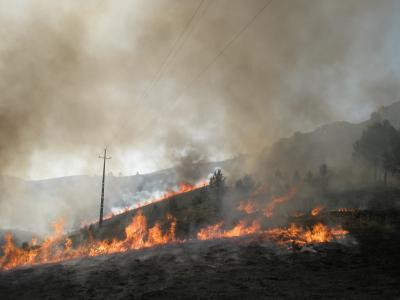WASHINGTON - When scientists torched an entire 22-acre watershed in Portugal in a recentexperiment, their research yielded a counterintuitive result: Large, hot fires do not necessarilybeget hot, scorched soil.
It's well known that wildfires can leave surface soil burned and barren, which increases the riskof erosion and hinders a landscape's ability to recover. But the scientists' fiery test found that thehotter the fire-and the denser the vegetation feeding the flames-the less the underlying soilheated up, an inverse effect which runs contrary to previous studies and conventional wisdom.
Rather, the soil temperature was most affected by the fire's speed, the direction of heat travel andthe landscape's initial moisture content. These new findings could help forest managers planwhen and where to ignite small controlled burns to reduce dry vegetation and restore theecosystem in at-risk areas, said Cathelijne Stoof, the soil and water scientist who led this study aspart of her PhD research at Wageningen University in the Netherlands.
A report about the experiment by Stoof, who is now at Cornell University in Ithaca, New York,and her colleagues has been accepted for publication by Geophysical Research Letters, a journalof the American Geophysical Union.
To study the real-world effects of landscape and fire dynamics on soil temperature, the researchteam mapped the watershed and installed instruments before setting the test area ablaze. Duringthe burn the scientists monitored the fire and the resulting soil temperatures. As expected, the firewas most intense in the heavily vegetated areas, but the topsoil in these regions remained"surprisingly cool" during the duration of the fire, Stoof explained.
"Vegetation is fuel, so the areas with more vegetation had more intense fire," Stoof said. "Butthe heavily vegetated regions also were also more moist, which protected the soil."

During an experimental burn in Portugal, researchers find that hot, intense fires yield cool underlying soil, contradicting previous research.
(Photo Credit: Cathelijne Stoof)
The areas with the hottest soil temperatures were in direct sunlight and had sparse, dryvegetation. "Because it's already dried out, it doesn't have the moisture shield that more denselyvegetated areas have to preserve the soil," Stoof said.
Other, previously observed behavior of fires could also help explain the new result, Stoof added."Fires moving fast will quickly burn up all the vegetation and also have little effect on the soil,but slow-moving fires will have much more time to heat up the soil and burn up its organicmatter and seeds," she noted.
Prior to this study, most of the research concerning fire effects on soil "took place in small scalefield or laboratory settings, where they only burned small plots," Stoof said. "But these plotshave less variation than a real watershed. If you have homogeneous conditions, you cannotextrapolate those results to the larger scale, where fire, soil and vegetation are heterogeneous."
Fire researcher Guillermo Rein of the Imperial College, London, called the results from Stoofand her colleagues "thought-provoking." They "go against the currently prevalent theory of soilheating," he said. "This paper ought to quickly mobilize the fire science community so that thissoil heating theory can be reconfirmed, refuted or reformulated."
From the new results, Stoof has devised a strategy to minimize soil damage during controlledburns. "You need to burn heterogeneous areas in two stages," Stoof said. "Burn the driest areafirst when it has some moisture. The damp area will be too damp, and therefore will not carryfire. Then go back and burn the damp area when it's dried out enough so that it will burn. Thisway you end up with minimum soil damage."
But in order to apply the results of this study universally, soil and fire scientists need to worktogether and study other types of landscapes, Stoof added. "We just studied one type ofenvironment and one fire. This experiment needs to be replicated so we can understand howdifferent vegetation and soil types are affected. If soil scientists work with fire scientists, theycan predict where the damage is going to occur and put up barriers to prevent erosion, or planprescribed burns strategically to minimize soil depletion."
Source: American Geophysical Union